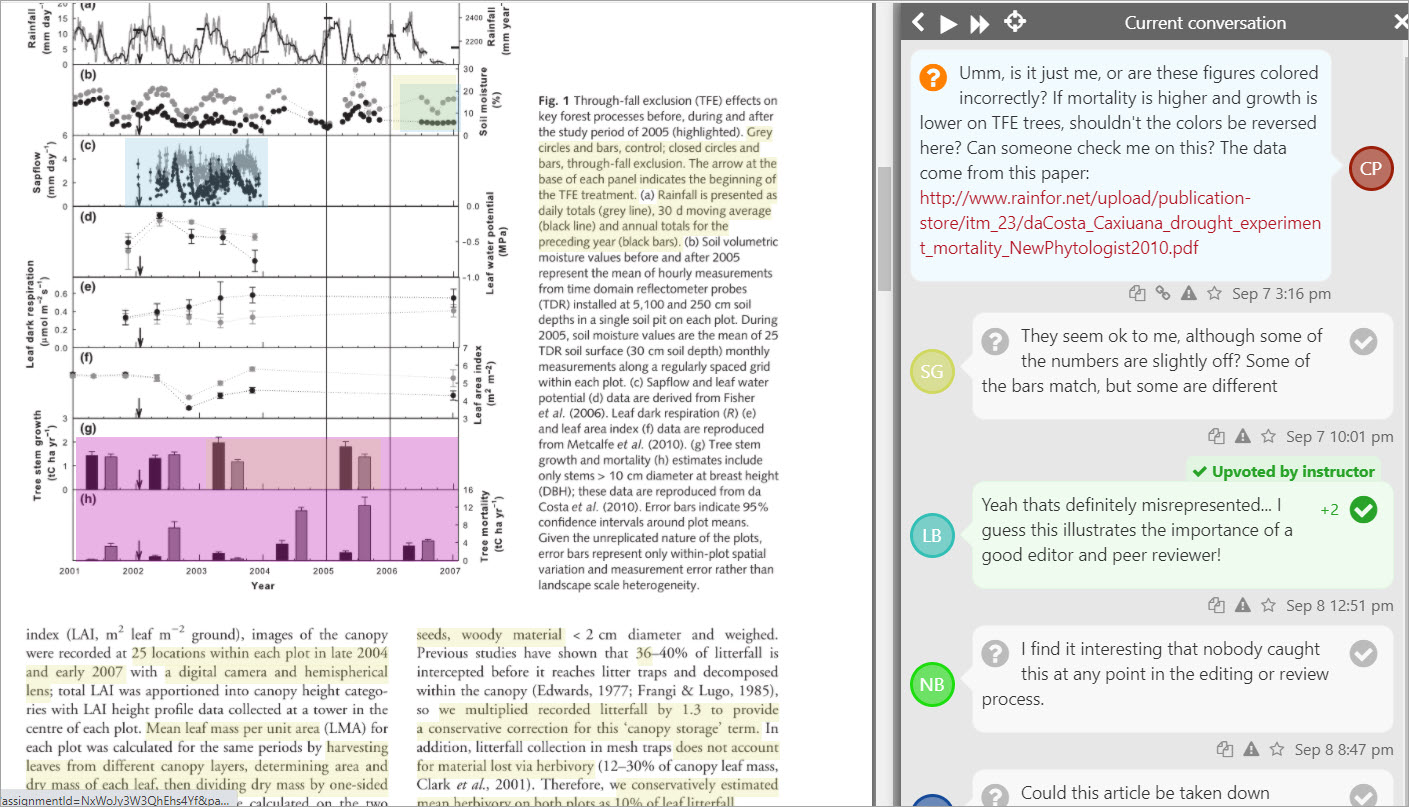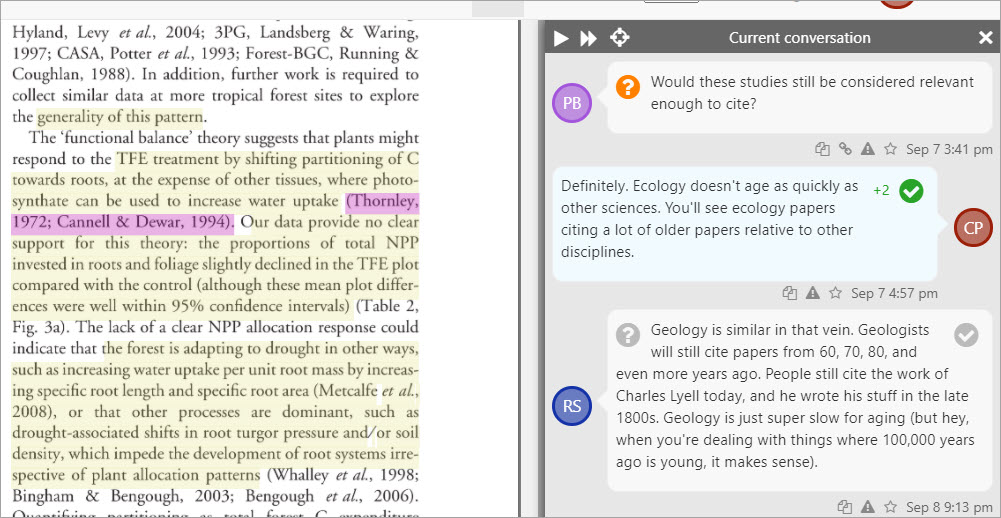Blogs

In Pursuit of Intrinsic Motivation Part 1: Interactive Reading Assignments with Perusall
By Julianne Morgan
“How do I know if my students are doing the readings?”
This age-old question of education became ever more prevalent during the shift to remote learning throughout the pandemic. In a face-to-face class, you can sort of get a sense about your students’ reading completion just by looking at their faces or listening to their remarks. This is obviously a lot harder to do when your students’ webcams are off, their faces are covered by masks, or they choose to be silent.
Over the summer, resourceful faculty participating in the FlexTeaching listserv found and shared a tool to help solve this problem: Perusall. Perusall is a free application integrated within Isidore where students and instructors can actively comment upon and answer questions about readings for your class.
As described by Perusall co-founder Dr. Gary King, humans are intrinsically motivated to find something called “collective effervescence:” a sense of unification and excitement generated by a group of individuals participating in the same action. Originally defined in reference to religious rituals, King believes that collective effervescence can be achieved even during the most solitary of activities - reading. I know what you’re probably thinking, because I’m thinking it, too - yeah, yeah, that sounds all nice and aspirational, but seeking a sense of collective excitement for a required reading has nothing to do with the reality of teaching and learning right now.
And that’s probably true, to a degree. Some of your students, especially right now, might be totally closed off to the notion of finding inspiration or meaning in the collective learning process. But some of your other students, as closed off as they may seem, may be seeking exactly this. Perhaps the relative isolation of the pandemic means they have actually more bandwidth for digital community-building. Perhaps they are wanting to engage more actively with their peers in asynchronous learning experiences.
This semester, Dr. Chelse Prather from Biology decided to give this idea a shot and uploaded her readings to the Perusall tool in Isidore. The results were astounding: “It’s literally like having a conversation about a paper in almost real-time, but over the course of a week (if you keep up with the comments/questions).”
In the example below, all the colored blocks on the page indicate students’ comments and questions.

This particular assignment was to read a 12-page study about shifts in plant respiration and carbon use efficiency in a drought experiment in the Amazon. With all due respect to ecologists, this paper doesn’t exactly sound like a real page-turner, and yet it generated 389 comments and 73 questions from Dr. Prather’s class of 39 students.
Now to be completely fair, this is an upper-level ecology class, so presumably, these students are already invested in learning the minutiae of calculating the mean leaf mass per unit area. But, still. 389 comments! This particular assignment was worth only 2.5% of their grade, too, so it’s not like there was a huge number of points riding on their demonstrated engagement with the reading.
I also don’t want to over-emphasize the number of comments without stressing the high quality of the posts. Too often, we see a high number of posts in discussion forums, but a large portion of the posts are to the tune of the ubiquitous din of “I agree!.” This was not the case for Dr. Prather’s Perusall readings. Students asked each other questions, looked up and shared definitions, compared and contrasted analyses from different readings, and pointed out important takeaways.
Perusall itself doesn’t make this educational magic happen, though. Study after study shows that active instructor participation in online discussions results in a richer conversation and a more positive student perception of the instructor and the class. Dr. Prather actively engages with the students and the reading throughout the week, so they know she’s looking for their questions and can help steer them to the right answers. She also sets students up for success with the readings by adding her own guiding questions to the reading that students can respond to. Lastly, she uses in-class Zoom time to summarize and discuss the outstanding questions and key points of the readings, further reinforcing the important concepts for the students.
For Dr. Prather, the students’ asynchronous dialogue about these readings means that she can cover more content than ever before. Moreover, the students were asking her questions that surprised (and seemingly delighted!) her. For example, when a student asked if it’s okay for ecology papers to cite studies from the 90s, she got the opportunity to explain to the class that ecology ages more slowly than other sciences:

I don’t know of a better collective learning experience than the opportunity to actually impact the broader academic community. Through her students’ discussions about a Perusall reading, they actually discovered a major error on a graph. Dr. Prather contacted the author, and an errata will soon be published to correct the problem. Just imagine the excitement and energy generated by this one group action! I bet at least 10 of her students will go home this Thanksgiving and tell their families that they were part of a group that found and corrected an error in an academic publication.
For Dr. Prather, the opportunity to build that in-class community through Perusall has been a game-changer: “I literally cannot say enough about how it has elevated my class discussions about papers. Maybe others are more effective at leading these discussions in class, but I think I will be using this moving forward whether I am online or not. It has really improved my teaching!”
For all the lofty educational ideals described in this post, I want to reiterate this point: Perusall is just a tool. Using it doesn’t mean your disengaged students will suddenly realize that, in fact, they actually love your subject and please let me annotate every reading in your class. Using it doesn’t mean you get any additional interaction at all. But, with just a little time and effort, I’m betting using Perusall with a few well-crafted questions will open that door to genuine interest for at least one of your students.
So, why not give Perusall a try?
Below are additional resources about Perusall to help you get started. Feel free to reach out to eLearning at elearning@udayton.edu to request advice on how best to prepare your students for a Perusall assignment, or what kinds of questions to add to Perusall to help guide their reading.
